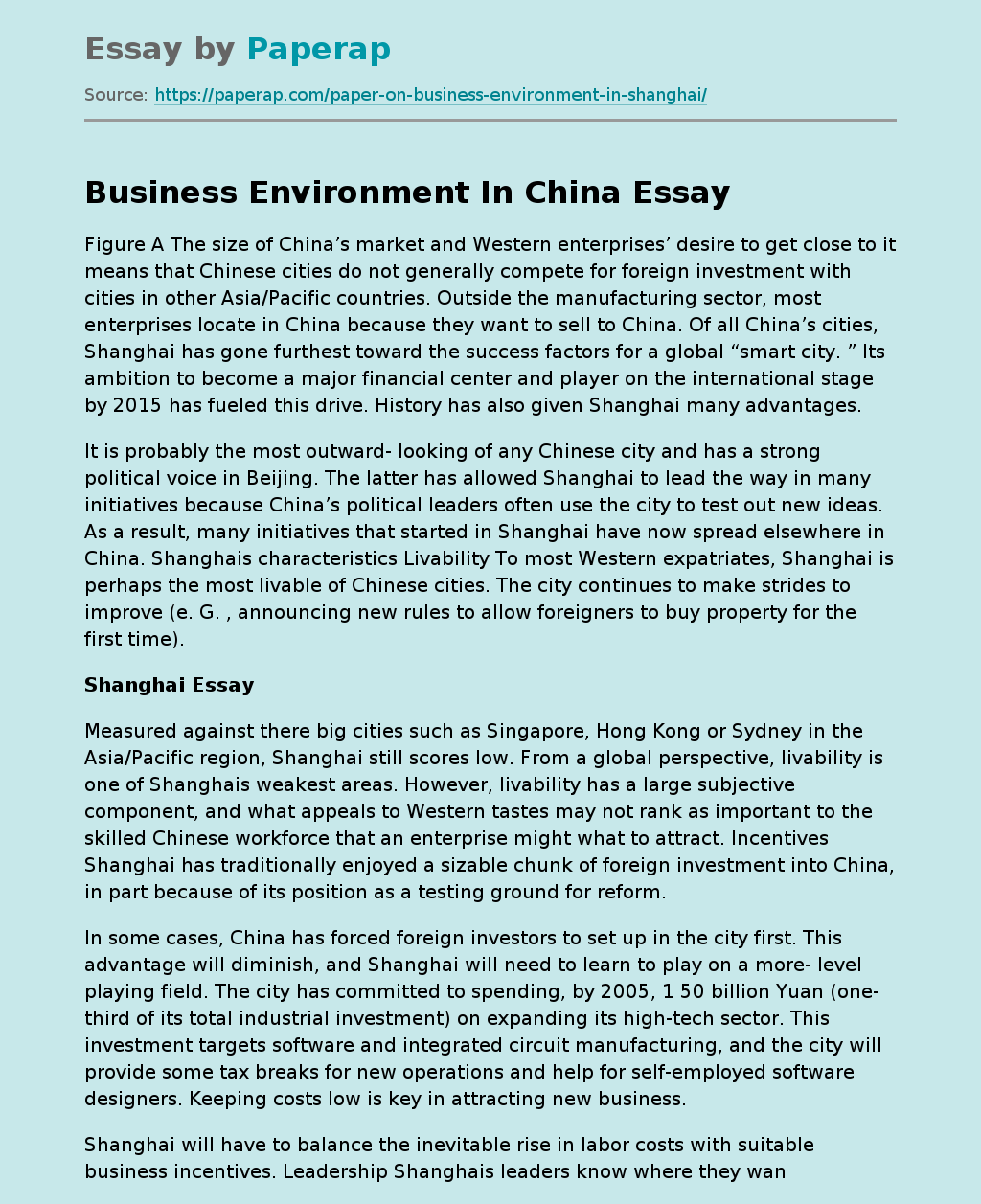Business Environment In China
The following example essay on “Business Environment In China” is an analysis of the financial market and foreign investment in Shanghai, which is the world’s most populated city.
The size of China’s market and Western enterprises’ desire to get close to it means that Chinese cities do not generally compete for foreign investment with cities in other Asia/Pacific countries. Outside the manufacturing sector, most enterprises locate in China because they want to sell to China. Of all China’s cities, Shanghai has gone furthest toward the success factors for a global “smart city.
” Its ambition to become a major financial center and player on the international stage by 2015 has fueled this drive. History has also given Shanghai many advantages.
It is probably the most outward- looking of any Chinese city and has a strong political voice in Beijing. The latter has allowed Shanghai to lead the way in many initiatives because China’s political leaders often use the city to test out new ideas.
As a result, many initiatives that started in Shanghai have now spread elsewhere in China. Shanghais characteristics Livability To most Western expatriates, Shanghai is perhaps the most livable of Chinese cities. The city continues to make strides to improve (e. G. , announcing new rules to allow foreigners to buy property for the first time).
Measured against there big cities such as Singapore, Hong Kong or Sydney in the Asia/Pacific region, Shanghai still scores low. From a global perspective, livability is one of Shanghais weakest areas.
However, livability has a large subjective component, and what appeals to Western tastes may not rank as important to the skilled Chinese workforce that an enterprise might what to attract. Incentives Shanghai has traditionally enjoyed a sizable chunk of foreign investment into China, in part because of its position as a testing ground for reform.
In some cases, China has forced foreign investors to set up in the city first. This advantage will diminish, and Shanghai will need to learn to play on a more- level playing field. The city has committed to spending, by 2005, 1 50 billion Yuan (one-third of its total industrial investment) on expanding its high-tech sector. This investment targets software and integrated circuit manufacturing, and the city will provide some tax breaks for new operations and help for self-employed software designers. Keeping costs low is key in attracting new business.
Shanghai will have to balance the inevitable rise in labor costs with suitable business incentives. Leadership Shanghais leaders know where they want to go during the next 10 or 1 5 years and what basic things they need to do to get there. However, they did not develop this vision in partnership with business or the community. Rather, as a command economy, decisions have been made by a select few behind closed doors. Thus, its leaders have greater ability to get things done quickly than leaders in democratic societies often have.
Cities such as Shanghai can complete projects without long internal or public debate over infrastructure projects that might take years in the planning stages in other Mounties and involve a myriad of agencies. Shanghai has benefited tremendously (certainly compared to the rest of China) from the pedigree of its leaders. President Kiang Gemini and Premier GHz Ironing are former leaders of Shanghai and have strongly supported the city. However, Shanghai knows that spending does not necessarily produce results.
Ten years ago, it started pouring money into redeveloping the riverside Pudding district into an area of towering skyscrapers, designed to be China’s version of Manhattan. Within a city of 16 million people, Pudding ended up as a ghost town. Slowly, occupation levels have risen, but largely cause the central government has “twisted the arm” of foreign enterprises rather than use real incentives. Infrastructure Many of the city’s hopes revolve around an ambitious project to link all of Shanghai to a giant high-speed data network, known as the Shanghai Inferior.
Scheduled for completion in 2010, the project stands out not just for its scale but also for its attempt to bring together many strands Of existing infrastructure (telecommunications and cable television especially) into one cohesive network. If it succeeds, Shanghai will be among the few cities in the world to have achieved such a feat. Five main projects will rely on the Inferior’s high-speed infrastructure: 1 Shanghai Information Interchange Network: A “giant intranet” for Shanghai with links to many kinds of information 2.
Shanghai Society Security Network: Designed to offer e-payment and checking and to facilitate the use of smart cards 3. Social Electronic Data Interchange .NET. ‘ark for Foreign Trade: An export/import data exchange for foreign trade 4. Social Community Service Network: Focused on the residential community 5. Gold Card and Commercial Value-Added Network: Linking banks’ automated teller machines (Atoms) and payment systems With 3. 2 million users, Shanghai claims to have the largest cable TV network of any city in the world, and this local-access network has a central part in Inferior.
Business Environment In China. (2019, Dec 05). Retrieved from https://paperap.com/paper-on-business-environment-in-shanghai/

